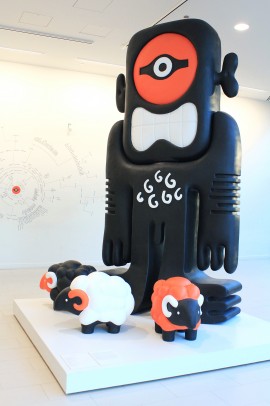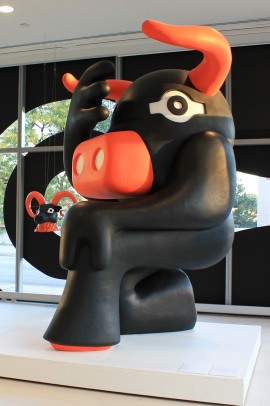National Hellenic Museum reveals the monsters among us
By Johnson Luo
Want to see the world in an ancient and fantastical way?
Head to National Hellenic Museum, 333 S. Halsted St., to check out the sensational Greek Monsters exhibit, developed by Beetroot and on display through May.
Greek monsters are fantasized understandings of physical and metaphysical problems that anyone may come across in daily life. These figures make it easy for people, especially children, to comprehend and interact with problems.
One of the first monsters featured in the exhibit are the Stymphalian Birds. These birds have iron beaks and metal feathers that can be used as projectile weapons. They always attack as a group, which is what makes them so formidable. Hercules, the legendary warrior and heir to Zeus, defeated them by knocking on cymbals to cause the birds to disperse and scatter. It’s a fantastical way of understanding the importance of teamwork and how easily any opponents can be defeated when in disarray.
Another rather well known Greek monster is Graeae: three ladies who share one eye and one tooth. She is a depiction of times that people have limited resources and must share for everyone’s wellbeing.
The Minotaur, a half-bull, half-human creature, is one of my favorites. He is somewhat a “Frankenstein’s creature” in the sense that he is conceived by mistake and that he is amoral, which means that he has no concept of good and bad. So he does evil things and causes damage without really knowing that he is doing so.
The Minotaur was eventually trapped in a labyrinth. Instead of trying to figure out a way to get out, he chooses to simply go straight and knock down every obstacle in his way. Somewhat adorable, wouldn’t you say? One great interpretation of the Minotaur is the spirit of thinking outside the box and not being tied down by conventions and the supposedly “ironclad” rules.
Greek mythologies also include monsters that represent more abstract and metaphysical problems. The Ophiotaurus, for instance, is related to the long-haunted wonderment of immortality. It is said that whoever finds and slays the Ophiotaurus, a bull that has snakes for its horns, gains immortality. It is understood that such a creature can never exist, and that is a way for the ancient Greeks to make peace with mortality.
Perhaps most well known of all Greek monsters is the Lernaia Hydra, a fierce and gigantic aquatic dragon with nine heads. When one of the Hydra’s heads is cut off, two more grow in its place. Hercules defeated the Hydra by having his nephew at his side to set fire to every head that’s cut off.
What is not commonplace knowledge, however, is that the Hydra is a primitive form of psychology. The Hydra could be seen as one’s emotional problems. If one chooses to suppress an issue, it only comes back worse. It is advisable to have another person on your side to be a good listener.
As visitors go even further in the exhibition, they will find the monster Proteus, a depiction of a very crude understanding of evolution.
Proteus was a real person whose son died in the Trojan War. He jumped into the ocean out of inconsolable grief, but he did not die. Instead, he was saved by the gods and transformed into a horse-mermaid creature and gained the ability to see the past and the future, among other magical abilities. Proteus’ ability to shape-shift is thought to be a primitive and crude understanding of evolution.
There are countless more sensational and incredible monsters in Greek mythology. I hope students find their way to this exhibition, which truly is a treasure house of knowledge, as well as wonder.
May you bear the speed of the Pegasus to sneak past Ladon, the treasure guardian at the door.
Greek Monsters
Exhibit on display through May
National Hellenic Museum
333 S. Halsted St.
Hours
Mon., Wed., Fri., 10 a.m.–5 p.m.
Thurs., 10 a.m.–8 p.m.
Sat., Sun., 11 a.m.–5 p.m.
Admission $8 for students with ID, $10 for adults



